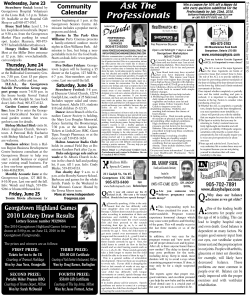
Teaching Letter-Sound Associations
Teaching Letter-Sound Associations by Rebecca Felton, PhD. Introduction In order to become proficient readers, students must learn to recognize and name the letters of the English alphabet. Students must also learn which letters and letter combinations are used to represent the sounds of the English language. Knowledge of the ways in which sounds map onto letters is referred to as the “alphabetic principle” or the “alphabetic code” and is a critical component of successful reading. Good readers often learn letter names through singing the alphabet song as preschoolers. They next learn to relate these names to visual shapes (letters) in preschool and kindergarten and then learn the correspondences between sounds and letters. This is followed by recognition of common patterns or combinations of letters used in English words. Research clearly demonstrates that good readers process each individual letter of words even though this is done very quickly and often without conscious attention to the process. This level of automaticity of word recognition allows the good reader to focus attention on the meaning of text. Poor readers often fail to master this information and have to be taught these skills before instruction in word identification and spelling can begin. Students with naming and retrieval problems will have particular difficulty learning letter names, letter-sound associations and recognition of common orthographic patterns. The errors that many poor readers make which are described as “letter reversals” (b for d) or “letter transpositions” (on for no) are often examples of difficulty learning the association between visual symbols or orthographic patterns and the name or sounds they represent in English. Principles of Instruction The general principles of instruction for students with persistent reading problems as outlined in Unit 2 are applicable to teaching letter-sound associations. 1. ASSESSMENT. Instruction should be based on an assessment that determines the student’s current skills in letter-sound associations. Most students identified as poor readers in elementary school have learned letter names and some sounds but many have not learned all of the letter-sound associations needed for accurate decoding and encoding. Vowel sounds are often the area of greatest weakness. 2. SEQUENTIAL and SYSTEMATIC instruction. Letter-sound associations should be taught in a logical sequence that proceeds in coordination with the decoding curriculum chosen. 3. Make instruction DIRECT and EXPLICIT and teach each association to MASTERY and AUTOMATICITY using extensive guided practice with frequent review of skills. 4. Use MULTISENSORY strategies to reinforce associations between letters and sounds. For students with naming/retrieval problems, the following additional instructional strategies are important: Strategies for Students with Naming/Retrieval Problems 1. Begin instruction with a SMALL SET of items. For example, select one short vowel and three or four consonants and teach these to mastery. Add additional items slowly with frequent review. It is not necessary for the student to learn the entire set of consonants and short vowel sound associations before decoding instruction begins. After one or two short vowels and a set of frequently used consonants have been mastered (e.g., a, i, t, b, s, f, m) decoding of closed syllable words of the consonant-vowel-consonant pattern can begin. 2. OVERLEARNING. Teach each association beyond the point of perfect performance. For students with retrieval problems, learning letter-sound associations to the level of automaticity required for good decoding and encoding requires EXTENSIVE PRACTICE. If students are moved too quickly into new material, they will “forget” the associations previously taught. The goal should be for students to quickly and accurately produce the associations under any conditions. Spend a portion of each lesson on review of previously taught material. 3. Teach and practice letter-sound associations in TWO DIRECTIONS: (1) teach the student to produce the sound when shown the letter/s and (2) teach the student to write or select the letter when given the sound. 4. Provide CUES to facilitate retrieval of letter-sound associations. Cues must be provided that will enable the student to retrieve and produce the letter name or sound that is being taught. Cues can include: Associations - teach the student to associate the letter-sound with a picture, key word and gesture. Examples of effective cues will be presented later in this unit. Kinesthetic and tactile - for some students, tracing letters while naming or giving the sound is effective. Focusing the student’s attention on how the sounds are produced (refer to units 4 and 5) can help with recall. Mnemonic devices - rhymes, songs and stories about the letter-sound associations can provide effective cues. When the student is asked to produce a name or sound, provide cues by giving part of the song, rhyme, story to the student. Color - make the distinction between vowels and consonants more salient by presenting vowels in one color and consonants in another. 5. AVOID GUESSING. Provide adequate cues at each step of the learning process so that the student does not practice making incorrect responses. If the student cannot retrieve the correct response, even with cues, simply provide the name/sound for them and ask them to repeat the item. With practice, the cues will become effective and will eventually no longer be needed. Sequence of Instruction 1. Based on assessment and decoding curriculum, select a small set of letter-sound associations to teach initially. Most decoding materials require the student to know at least one short vowel and a small set of consonants for beginning instruction. Teach the students to correctly pronounce the sounds first (can be done during phonemic awareness instruction) and then the letters that are used to represent those sounds. See the suggestions in the next section for introducing the concept of sound to letter correspondence. 2. For each set, teach letter shapes and letter names as needed. Some students require instruction in letter formation as well as recognition and naming. The decision to use cursive or manuscript depends on the student; students who have significant difficulty with letter formation, spacing, etc. may benefit from an occupational therapy evaluation. 3. Review the two types of sounds: vowels are open sounds and consonants are closed sounds. This information should have been presented during phonemic awareness instruction 4. Teach the links between the two types of letters and the two types of sounds (vowels and consonants). 5. Practice these associations using cues (see suggestions below) until the links are automatic. 6. Add new associations as needed for decoding and spelling. 7. Provide frequent review of associations previously taught. Introducing the Concept of Sound to Letter Correspondence 1. Ask students to draw a spoken word: for example, a tree, house, or person. 2. Discuss how they were able to do this (we have seen these objects, know what they look like, etc.) 3. Ask students to draw a sound - give them a consonant sound and ask them to “draw” the sound. 4. Discuss how they were able to do this (somebody taught us the letters; we have an alphabet in English, etc.) 5. Guide a discussion of how spoken language came first in humans and then different ways were developed to represent sounds. Show examples of different writing systems: for example, pictographs (students may be familiar with cave drawings), languages that use completely different symbols (such as Chinese, Arabic), and languages that use the same alphabet letters as English (such as French). 6. Explain that you and the students will be learning about the different ways sounds are spelled in English so that they can read and spell words even if they have never seen them before. Most words in English (87%) can be read and spelled once these associations and spelling conventions are mastered. Examples of Multisensory Cues In addition to teaching key words and providing picture cues, students may be provided with experiences that involve touch, motor movement, taste and smell. Examples: Write letters in the air (on the table, on a textured surface) while the letter name or sound is produced. Provide slices of apple to eat when the a- apple - /a/ connection is taught. Make partial, lengthwise slices in hot dogs and then drop them into boiling water. The result looks a lot like an octopus (o -octopus -/o/) and can be eaten! Make gestures such as actually scratching an “itch” as a cue for the short /i/ sound or give a pinch as the gesture for the /ou/ in the keyword ‘ouch.’ Students make letter shapes with their bodies. The videotape “Alphabet Soup” by William Wegman shows his famous dogs forming each of the letters of the alphabet and could be a stimulus for this activity. Strategies for Teaching Letter-Sound Associations Using Cues For any cue to be effective, it must be directly taught and then practiced. Teachers and parents should model using the cues in association with the letter-sound associations that are being taught. Some students will require a great deal of practice using the cues to facilitate recall. Only when the letter-sound association has been learned to the level of automaticity should the cues be removed. 1. PICTURE CUES. Pictures of items that begin with the sound that the letters make can be effective cues if these are kept on display and referred to frequently during the teaching process. Teachers can superimpose an object or animal onto the shape of the letter such as a snake in the shape of the letter S. Other pictures are simply a clear representation of an item that begins with the sound to be learned. The picture should always include the letters that represent the sound. 2. GESTURES. Gestures are very effective cues and are recommended for the short vowel sounds which are so difficult for many poor readers. For maximum effectiveness, pair the gesture with a picture cue and teach together. 3. KEY WORDS. A similar strategy is to teach the student to associate the letter with a key word which contains the sound. 4. STORIES, CHANTS, RHYMES. These can be used to introduce sounds for particular letters and can be referred to as cues for retrieval. For example, a story beginning with “Susie snake sat in the sand Š” provides lots of examples of the /s/ sound and can be used as a retrieval cue. Stories can also be used to help students understand concepts relating to letter-sound relationships.
© Copyright 2025





















